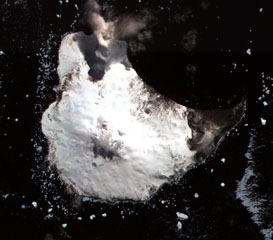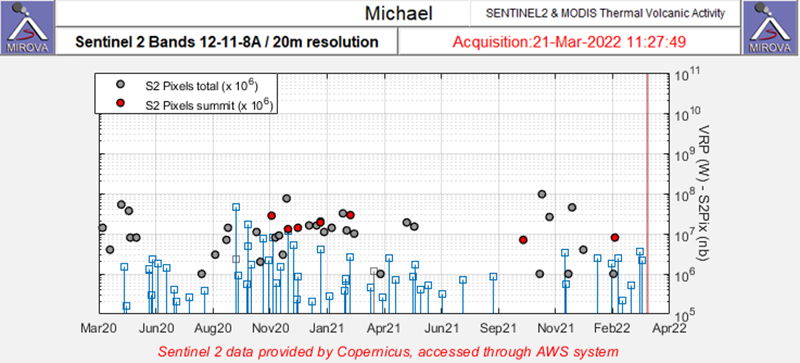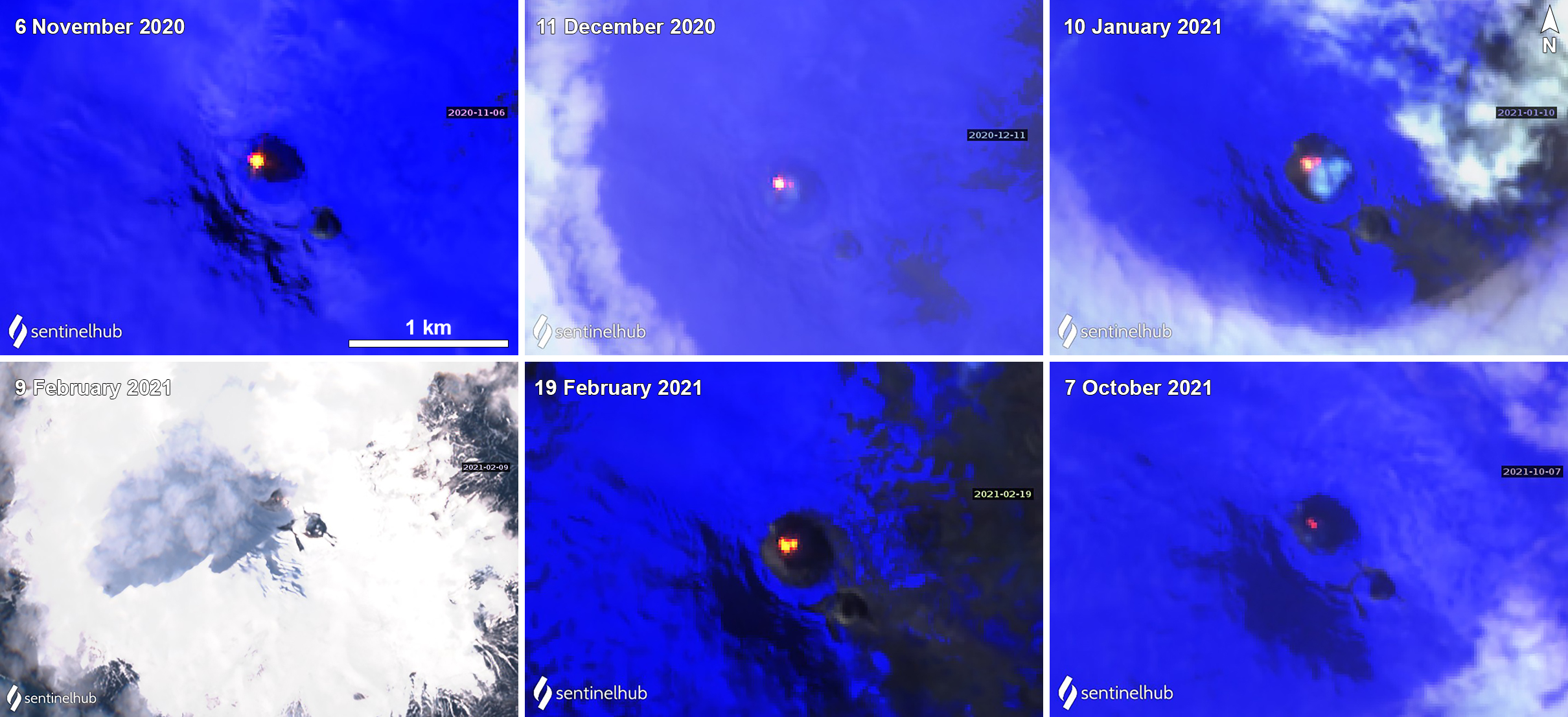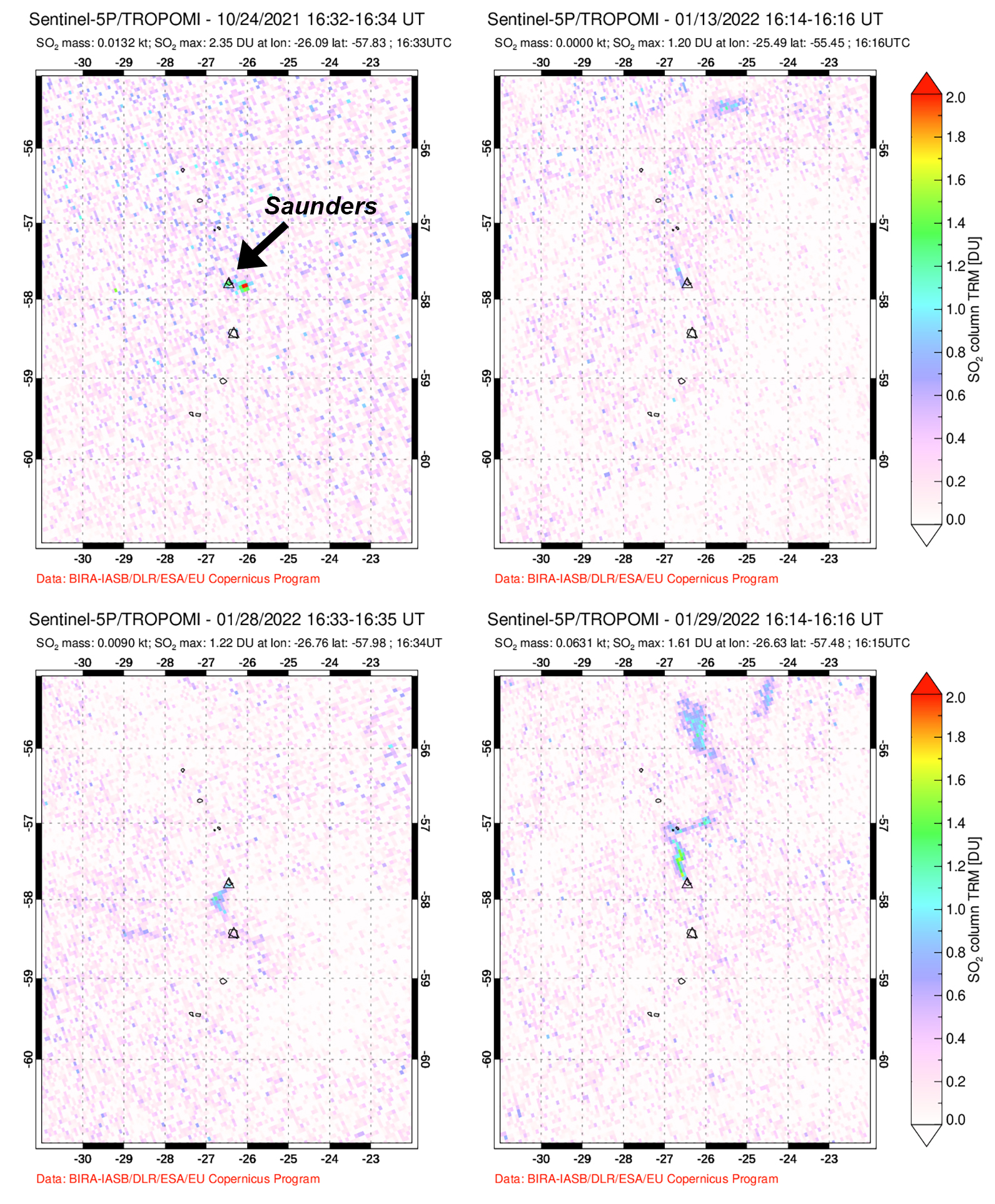Report on Saunders (United Kingdom) — March 2022
Bulletin of the Global Volcanism Network, vol. 47, no. 3 (March 2022)
Managing Editor: Benjamin Andrews.
Edited by Kadie L. Bennis.
Saunders (United Kingdom) Intermittent thermal anomalies and some gas-and-steam emissions during June 2020-January 2022
Please cite this report as:
Global Volcanism Program, 2022. Report on Saunders (United Kingdom) (Bennis, K.L., and Andrews, B., eds.). Bulletin of the Global Volcanism Network, 47:3. Smithsonian Institution. https://doi.org/10.5479/si.GVP.BGVN202203-390090
Saunders
United Kingdom
57.8°S, 26.483°W; summit elev. 843 m
All times are local (unless otherwise noted)
Saunders Island, located in the remote South Sandwich Volcanic Arc in the South Atlantic, consists of a large central edifice intersected by two seamount chains. The primary volcanic features include Mount Michael, which contains a 500-m-wide summit crater, the northern Blackstone Plain, and the Ashen Hills, which is a group of overlapping craters formed through phreatomagmatic activity. The current eruption period began during November 2014, characterized by elevated crater temperatures and gas-and-steam emissions (BGVN 46:02). Visits are infrequent because of the remote location and often views are obscured by cloudy weather. This report updates information during June 2020 through January 2022 primarily using satellite data.
Activity has been relatively low since June 2020; no thermal activity was detected in satellite data until November 2020, when it occurred intermittently until February 2021, according to MIROVA data (figure 43). Although weather clouds often obscured the views of the summit, gas-and-steam emissions drifting NE were possibly visible in satellite images on 24 October 2020. A clear view of the crater on 6 November showed a strong thermal anomaly on the crater floor in infrared satellite imagery (figure 44). According to Suomi NPP/VIIRs sensor data, thermal anomalies were detected on 3 and 8 November 2020 and 11 January 2021. On clear weather days during late 2020 into 2021, anomalies were strongly observed in the summit crater at Mount Michael, based on Sentinel-2 infrared satellite imagery (figure 44). Small gas-and-steam emissions were detected on 10 January 2021. On 9 February a grayish plume drifted W from the summit crater, according to natural color satellite imagery (figure 44).
Renewed anomalies were visible again during October 2021 in MIROVA data. Although on 7 October the strength of the anomaly had decreased visibly compared to the previous year (figure 44). Small sulfur dioxide emissions were visible on 24 October 2021, as detected by the TROPOMI instrument on the Sentinel-5P satellite (figure 45). Wispy sulfur dioxide emissions were more often detected during January 2022, which drifted generally N and SW.
Geological Summary. Saunders Island consists of a large central volcanic edifice intersected by two seamount chains, as shown by bathymetric mapping (Leat et al., 2013). The young Mount Michael stratovolcano dominates the glacier-covered island, while two submarine plateaus, Harpers Bank and Saunders Bank, extend north. The symmetrical Michael has a 500-m-wide summit crater and a remnant of a somma rim to the SE. Tephra layers visible in ice cliffs surrounding the island are evidence of recent eruptions. Ash clouds were reported from the summit crater in 1819, and an effusive eruption was inferred to have occurred from a N-flank fissure around the end of the 19th century and beginning of the 20th century. A low ice-free lava platform, Blackstone Plain, is located on the north coast, surrounding a group of former sea stacks. A cluster of cones on the SE flank, the Ashen Hills, appear to have been modified since 1820 (LeMasurier and Thomson, 1990). Analysis of satellite imagery available since 1989 (Gray et al., 2019; MODVOLC) suggests frequent eruptive activity (when weather conditions allow), volcanic clouds, steam plumes, and thermal anomalies indicative of a persistent, or at least frequently active, lava lake in the summit crater. Due to this observational bias, there has been a presumption when defining eruptive periods that activity has been ongoing unless there is no evidence for at least 10 months.
Information Contacts: MIROVA (Middle InfraRed Observation of Volcanic Activity), a collaborative project between the Universities of Turin and Florence (Italy) supported by the Centre for Volcanic Risk of the Italian Civil Protection Department (URL: http://www.mirovaweb.it/); NASA Global Sulfur Dioxide Monitoring Page, Atmospheric Chemistry and Dynamics Laboratory, NASA Goddard Space Flight Center (NASA/GSFC), 8800 Greenbelt Road, Goddard MD 20771, USA (URL: https://so2.gsfc.nasa.gov/); NASA Worldview (URL: https://worldview.earthdata.nasa.gov/); Sentinel Hub Playground (URL: https://www.sentinel-hub.com/explore/sentinel-playground).




